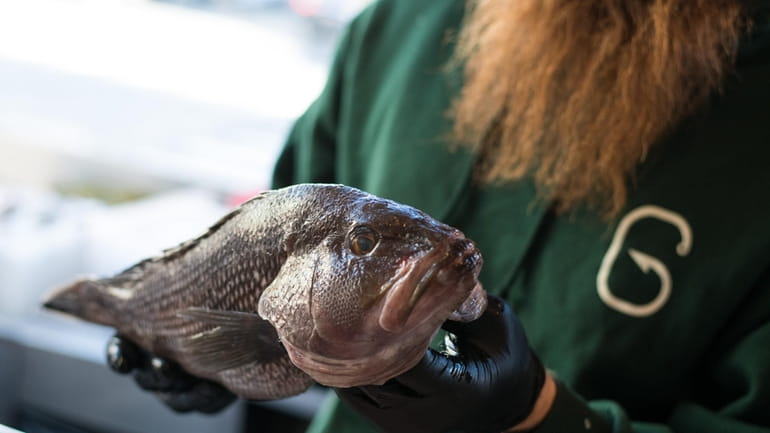State mulls new recreational limits on black sea bass, porgies

The minimum size for black sea bass could rise to 16.5 inches from last year's 16 inches. Credit: Corey Sipkin
State fisheries regulators are finalizing plans that could set new limits on the recreational catch of abundant black sea bass and porgies, including shorter seasons, fewer keeper fish and an increase in minimum size.
Meanwhile, the state, following mandates handed down from interstate fisheries regulators, plans to keep fluke regulations the same as last year.
The proposed changes, to be presented in a meeting with fishermen later this month, come as some observers, including a top former regulator, question the survey methods and data on which the new rules are based. The state said the new restrictions are needed to meet a 10% reduction handed down by the Atlantic States Marine Fisheries Commission and the Mid-Atlantic Fisheries Management Council.
Managers at the state Department of Environmental Conservation met last month with a local fisheries management council on the proposed changes. Measures being considered on recreational fishing for black sea bass include increasing the minimum size of keepers to 16.5 inches (from the current 16 inches), reducing the season by up to six weeks in the fall-winter period (or a later summer start), and a cut in the number of fish that can be taken daily, which last year stood at six during the fall.
The rules, expected to be finalized by the spring, could include a combination of the measures. The DEC stressed the measures are "still being revised," with public input before being posted.
Tyler Quaresimo, captain of a charterboat from Montauk whose family also operates the partyboat Miss Montauk, acknowledged the state’s “hands are tied to a certain extent because of what the feds give them,” but said the new restrictions will only worsen the situation.
“We’ve already lost our sea-bass fishery because of the regulations,” he said. “No one’s coming out here to Montauk for six black sea bass, so reducing it to five fish won’t make a difference.” But throwing back more fish would be a “huge problem because you can’t get away from the things.”
Porgies caught from recreational fishing boats, including party or charterboats, could be subjected to a 10.5-inch minimum size limit, from the current 10 inches, and the take would be reduced to 40 per day from the current 50, during a portion of the season from Sept. 1 to Oct. 30, according to information provided to the Marine Resources Advisory Council.
The DEC is also planning reductions in the commercial harvest of black sea bass, also by around 10%, to 469,697 pounds this year from last year’s 633,413 pounds. Commercial landings last year fell well under the quota, at 581,652, the DEC said.
For porgies, commercial fishermen’s quota this year could drop to 863,535 pounds during a May-to-September period compared with last year’s 1.25 million pound harvest limit, after landings last year topped 1.28 million pounds, the DEC reported.
The state is planning to increase the commercial take of bunker, or menhaden, to around 4.3 million pounds from last year’s 2.9 million, after fishermen took only well under half last year’s commercial quota, at some 985,775 pounds.
In a statement, the DEC said it’s “required to make a 10% reduction for the recreational black sea bass and scup fisheries” this year and that it continues to work with two interstate fisheries management agencies “to determine measures that will accomplish the 10% reduction” while ensuring the state’s fisheries “are sustainable and conserved for future generations to enjoy.”
The measures come as fishermen and even a former regulator acknowledge that black sea bass targeted for reduced harvest are among the most commonly found around Long Island waters.
“Black sea bass have been pretty consistently” plentiful, said Jim Gilmore former director of the DEC’s marine resources division. “If you’re fishing, you can’t get away from them. They’re all over the place.”
Gilmore recently retired from the DEC after 37 years at the agency, including 15 in the marine program. He continues to teach fisheries management at Stony Brook University.
“The mess with black sea bass [management] has got to get fixed,” Gilmore said. “It doesn’t make any sense.”
The problem, he said, is that a federal law aimed at rebuilding fish population, known as the Magnuson-Stevens Act, needs to be updated, and data that is used in determining the health of populations is “not making sense anymore,” particularly for black sea bass.
Worse, he said, measures such as increasing the size of keeper black sea bass will force anglers to expend more effort fishing to catch fish big enough to keep, likely increasing fishing mortality.
Fishermen agree.
“It’s Catch-22 management,” said Steve Witthuhn, a Greenlawn charterboat captain who fishes from Montauk and is a member of MRAC. “The science is telling us there’s plenty of fish out there, but management has to [account] for last year’s overage” tied to increased release discard mortality.
Last year, Witthun said, “We had to catch 200 fish to keep 40 fish for my customers” at 16 inches. If the limit increases to 16.5-inches, he said, “we might have to catch another 30-40 fish” to catch one in the new size limit.

Updated now Newsday travel writer Scott Vogel took the ferry over to Block Island for a weekend of fun.

Updated now Newsday travel writer Scott Vogel took the ferry over to Block Island for a weekend of fun.

